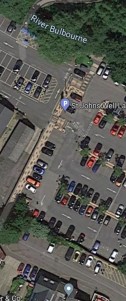A lost Hertfordshire well – St John’s Well, Berkhampsted
The town once boasted the most famed well in Hertfordshire, which was called St. John’s Well. The earliest dedication would appear to be St. James, as it was associated with a chapel to the saint on the south side of the main road. Apparently it gained the other dedication when a guild of the brotherhood of St. John the Baptist took over its care.
Thus its history is a little confused and probably tainted by antiquarian half truths. For example after the establishment of nearby monastic society in the Saxon period, the monks were obviously distressed to find such pagan activities continuing. Rather than forbid any such activity, one monk, through a dream, was told the solution. He should re- dedicate the well to St. John the Evangelist, and thus create a Christian focus for the sick who bathed here. Although successful, it did not apparently stop all such ‘pagan’ worship. Indeed, in the late 1100s it is reported that Hugh of Grenoble, Bishop of Lincoln journeyed the considerable distance to prevent „pagan‟ activities such as dressing the well, although there is no record of this in the appropriate documentation of the period. Certainly a fair on St. James’s Day may have been established to overcome these problems. Travelers of all types refreshed themselves at the well, benefiting from the healthy waters, and would rest at the monks’ hospitality: little booths being built to house travelers.
Its waters were believed to cure a variety of ailments: eye soreness, Kings evil (scrofula), and leprosy. Suffers from the latter problem apparently were looked after in a leper hospital. All these ailments were commonly experienced by the crusaders, and hence it received heavy patronage during this period. Water was even carried to those unable to reach the well, receiving an extra blessing from the conferred to the person. This however was frowned upon and fines were imposed for such activities, such as in the 1400s when two officials of the Portmote Court were appointed to protect the spring (then the town’s principal supply) from such spoilage. The last noted of these officials was a Geoffrey Fitz Piers, of the said brotherhood.
When the Reformation dissolved the monastic society; the monk’s houses, landscaped gardens and the spring, became broken down, derelict and overgrown. With the lack of any Christian overseers, apparently the old ways resurged. People began to assemble at night, to undertake rituals. In the 17th century a local physician, Dr. Woodhouse, used the holy water to use against frenzy: exorcising evil spirits. Despite containing ‘spa salts’, it was not exploited and 1865 the water was declared by the local authorities to be unfit for drinking, and should be used only for gardens.
Until the 1930s the well’s water still flowed over stones and down a shallow channel along St John Well’s Lane when a post office was built over the site of the leper. Now the post office is gone and housing over the site. The well being lost forever.
Taken from Holy wells and healing springs of Hertfordshire.
Posted on December 18, 2023, in Hertfordshire, Pagan gods and tagged Holy Well, Holy well blog, holy wells, Holy wells blog, Holy wells healing springs Spas folklore local history antiquarian, Holywell blog, Pagan. Bookmark the permalink. Leave a comment.

Leave a comment
Comments 0